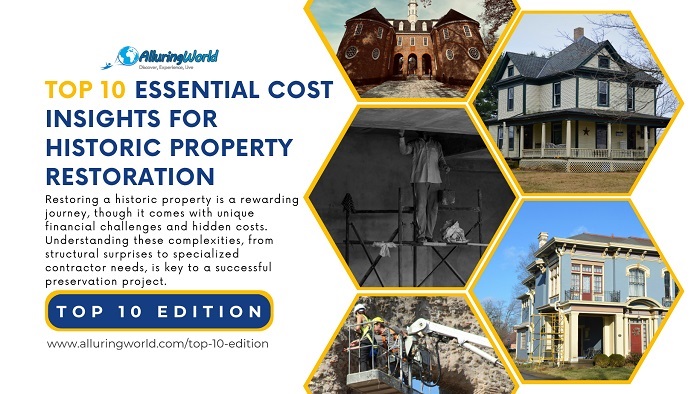Restoring a historic property is a profound undertaking, offering immense satisfaction as you preserve a piece of architectural heritage. Yet, it’s also a journey filled with unique challenges, especially when it comes to the financial aspects. Unlike modern renovations, restoring an older home often reveals surprises that can significantly impact your budget and timeline. Before you dive into the rewarding world of historic preservation, understanding the potential costs and complexities is crucial. Here are 10 key things you need to know about what it costs to restore a historic property.
1. The General Price Tag: Expect $100 to $300 Per Square Foot
Historical renovation projects typically range between $100 and $300 per square foot, depending on the scope and complexity. This means total project costs often fall between $150,000 and $450,000 for a standard-sized home. However, the numbers can escalate quickly based on the property’s condition, location, and historical significance. For instance, restoring a Victorian-era townhouse in San Francisco often exceeds $500,000 due to stringent city codes and scarcity of period-appropriate materials. At the same time, a 19th-century stone farmhouse in rural New York might cost less but still present challenges like outdated infrastructure.
2. Windows: A Significant Hidden Cost at $1,000-$3,000 Each
Unlike modern replacements that might cost $300 to $700, period-authentic wood-framed windows for historic properties can run $1,000 to $3,000 each. These are often custom-made or meticulously restored to maintain the home’s original character, making them a substantial expenditure.
3. Plumbing: Old Pipes, New Costs – $250-$1,000 Per Linear Foot
Replacing century-old cast-iron or clay pipes is a common necessity in historic renovations for safety and functionality. This can be a major hidden cost, often ranging from $250 to $1,000 per linear foot, depending on the complexity of the installation and access.
4. Electrical Rewiring: An Essential Upgrade Totaling $8,000-$15,000
Full rewiring for safety and code compliance is almost always required in older homes. This critical upgrade can cost anywhere from $8,000 to $15,000, ensuring your restored property meets modern electrical standards without compromising its historic fabric.
5. Structural Surprises: Budget an Extra 20-30% for the Unexpected
Hidden damage behind walls or beneath floors is a frequent discovery in historic renovations. These structural surprises—which can include issues like rot, foundation problems, or inadequate framing—may add 20% to 30% to your original budget. It’s vital to have a contingency fund for these unforeseen issues.
6. The Regulatory Layer: Permits and Preservation Reviews Add 10-15% and Time
Depending on the property’s location, it may be subject to local or state historic preservation laws. This often requires preservation consultant fees ($100–$250/hour), special permits ($500–$2,000), and multiple plan reviews. For homes in areas like New Orleans’ French Quarter, extensive oversight is common, adding 10–15% to your overall costs and potentially delaying construction by several months.
7. Financial Aid Exists: Leverage Grants, Tax Credits, and Incentives
While costs can be high, several financial resources exist to ease the burden. These include the Federal Historic Preservation Tax Credit (offering 20% back on qualified expenses for income-producing properties), state-level tax credits (many states offer 10–25% additional credits), grants and low-interest loans from local preservation societies, and property tax abatements or freezes from city programs. Explore these options to significantly reduce out-of-pocket expenses.
8. Don’t Skip the Architectural Survey: Save 25-40% on Budget Blowouts
One of the most common pitfalls is skipping an architectural survey. A thorough analysis (costing $2,000–5,000) can identify potential issues early, preventing mid-project changes that could inflate budgets by 25–40%. This initial investment is crucial for comprehensive planning.
9. Hire the Right Contractor: A Specialist Prevents 15-25% in Fixing Mistakes
Choosing the right contractor is critical for historic preservation. While commercial general contractors are adept at modern builds, historic restoration demands specialized expertise. A lack of this specific knowledge can result in the use of incompatible materials or damage to original features, potentially adding 15–25% to your final bill in corrections. Always ensure your chosen contractor is a specialist well-versed in the era and materials of your property.
10. Expect Delays: Historic Renovations Take 30-50% Longer
Historic renovations typically take 30–50% longer than modern ones. A full home restoration often takes 12 to 18 months, compared to 6 to 8 months for a standard renovation. Delays stem from waiting on custom materials, extended permitting processes, and the discovery of new issues. Be prepared for this extended timeline, as each additional month can add 2–3% in labor and loan costs.
Restoring a historic property is more than just a construction project; it’s an act of stewardship and a profound connection to the past. While the financial commitment can be substantial and the process often takes longer than anticipated, the emotional and cultural value is immeasurable. You’re not just fixing walls—you’re preserving a story, breathing new life into a unique piece of history, and often fostering deeper community involvement.
With thoughtful planning, a realistic budget that accounts for the unique challenges of historic homes, and the right team of specialists, you can avoid common pitfalls and ensure your project honors both the past and your pocketbook. Before you begin, a consultation with a preservation architect or renovation specialist (for around $500–$1,000) is a wise investment to guide you through the process effectively. Done well, preserving history isn’t cheap, but it truly is priceless.

